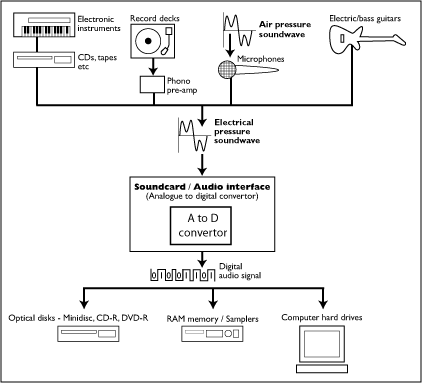
PCM audio
This process is sometimes referred to as Pulse Code Modulation (PCM) and digital audio sometimes referred to by the generic term "PCM audio".
The advantages of digital systems over conventional analogue audio tape recorders are discussed here.
A knowledge of the principal theories of conversion (sample rate and bit depth) is essential knowledge for music technologists and sound recordists who need to control quality and file size of their digital audio files. Quality of A to D conversion is paramount if we are to record to the best quality with as little distortion as possible.
DAC's (digital to analogue converters)
The process of re-creating an analogue audio wave from digital PCM data (in order that it may be recorded or sent to a monitoring system) is handled by a digital to analogue converter (DAC). This involves a process know as "successive approximations" and is of interest to digital audio designers but not essential knowledge for music technologists and sound recordists.
It's probably fair to say that all semi-professional and professional grade D to A converters are of a sufficiently high standard and need not concern us unduly, and besides, we really have little or no control over what quality of equipment the audience is using. It's the A to D conversion that we must pay most attention to.
Where can converters be found?
| Device | A to D | D to A (DAC) |
|---|---|---|
| Stand alone | 2 - multiple | 2 - multiple |
| Mobile phone | 1 (mic) | 2 (L & R headphones) |
| Hardware sampler | 2 (L & R) | Multiple (individual & stereo?) |
| Soundcard | 2 (L & R) | 2 (L & R) |
| Audio interface | 2 - multiple | 2- multiple |
| FX processor | 2 (L & R) | 2 (L & R) |
| CD player | - | 2 (L & R) |
| CD recorder | 2 (L & R) | 2 (L & R) |
| Mini disc | 2 (L & R) | 2 (L & R) |
| Digital mixer | Multiple | Multiple |
| Alesis ADAT | 8 | 8 |
| Digital synthesiser | - | 2 (L & R) |
| iPod | - | 2 (L & R) |
| DVD player | - | 2 (L & R) |
| DVD recorder | 2 (L & R) | 2 (L & R) |
